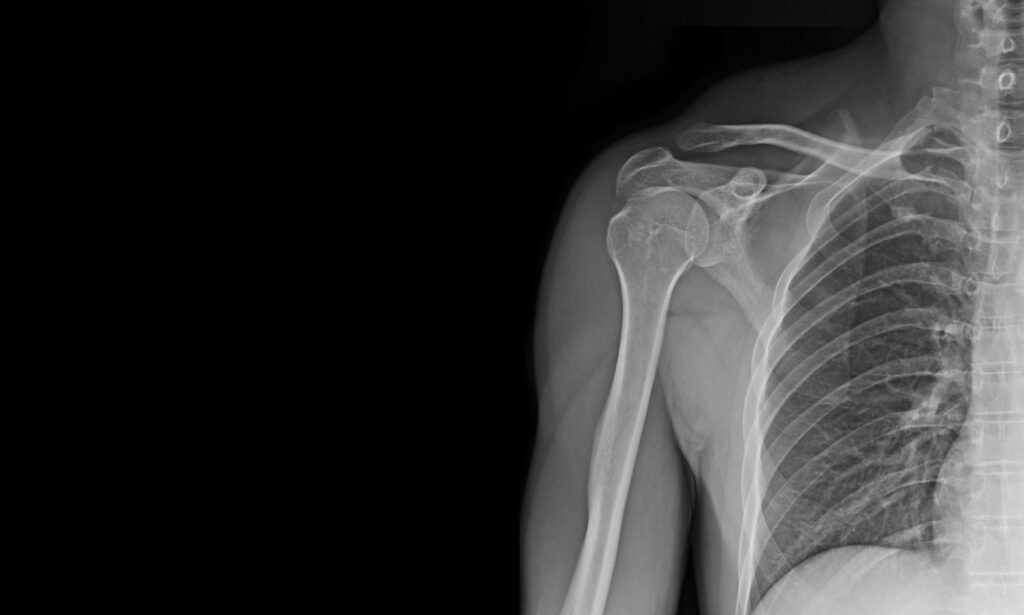Have you been wondering how to relieve arthritis pain in your shoulder? Shoulder pain due to arthritis can change your active lifestyle and make daily tasks difficult. In this post I will explore easy way to help reduce your pain, potential home remedies, medical treatments, and when it is time to seek advice from your orthopedic shoulder surgeon.
Key Takeaways
- Shoulder arthritis is the inflammation and degeneration of the shoulder joint, leading to pain and stiffness, typically diagnosed through an X-ray, reveals joint space narrowing and the presence of bone spurs.
- Non-surgical treatments for shoulder arthritis include lifestyle modifications, over the counter NSAIDs, and physical therapy, aimed at managing pain and improving your quality of life without surgery.
- When conservative treatments fail, shoulder surgery options such as joint replacement or arthroscopic debridement can be considered, followed by a careful recovery and rehabilitation process.
Understanding Shoulder Arthritis
Shoulder arthritis is characterized by inflammation and cartilage degeneration within the shoulder joint, leading to pain and reduced mobility. As the cartilage thins, the joint space decreases, causing increased friction and discomfort during movement. This condition results from several factors, such as:
- Osteoarthritis
- Rheumatoid arthritis
- Post-traumatic arthritis
- Rotator cuff tear arthropathy
Arthritis can target different shoulder parts, mainly the glenohumeral and acromioclavicular joints. This results in pain and stiffness that can make everyday movements difficult. The condition is often due to degenerative joint disease, which affects the joints, the rotator cuff tendons, and the bones in the shoulder area, including the shoulder blade and upper arm.

Symptoms of shoulder arthritis typically include localized pain and stiffness in the joint. To confirm a diagnosis of this condition, your orthopedic shoulder surgeon will utilize X-rays to detect key indicators such as narrowing of the joint space and the presence of bone spurs. Recognizing these symptoms and accurately diagnosing shoulder arthritis are crucial first steps in developing an effective treatment plan to manage this debilitating condition.
Non-Surgical Pain Relief Options
When shoulder arthritis impacts daily activities, managing shoulder pain becomes a critical concern. Fortunately, there are non-surgical treatment options available that can help to alleviate pain for some patients. These include lifestyle modifications, appropriate use of over-the-counter medications, and physical therapy. These approaches are essential to symptom management. They focus on improving quality of life and reducing discomfort without surgical procedures.
Lifestyle Modifications
Managing shoulder arthritis effectively involves understanding the balance between activity and rest. Lifestyle modifications are crucial in controlling the pain and discomfort associated with this condition. It’s essential to be aware of the activities that exacerbate pain and to avoid further aggravation.
Simple changes in daily routines, such as altering how you reach for items or taking regular breaks to rest the shoulder, can significantly impact the progression and experience of shoulder arthritis.
Management isn’t only about eliminating harmful activities; it also involves adopting new practices beneficial for joint health. Incorporating these gentle, joint-friendly activities can help maintain the health of your shoulder. Engaging in these lifestyle changes is a proactive form of self-care that enhances well-being without needing medication.
Over-the-Counter Medications
When addressing the discomfort associated with shoulder arthritis, nonsteroidal anti-inflammatory drugs (NSAIDs) can be effective in reducing inflammation and pain. These over-the-counter medications are accessible but should be used with caution to provide short-term pain relief while minimizing potential side effects.
Some common NSAIDs include:
- Ibuprofen (Advil, Motrin)
- Naproxen (Aleve)
- Aspirin (Bayer, Bufferin)
- Celecoxib (Celebrex)
It is crucial to consult with your orthopedic shoulder surgeon before starting any new medication, especially if you have any underlying health conditions or are taking other medications. This consultation ensures safe and appropriate use of these drugs in managing your arthritis symptoms.
Physical Therapy
The shoulder is complex, made of muscles and tendons that work together to facilitate movement. When arthritis affects these muscles and tendons, physical therapy can be essential to help regain and maintain range of motion. Through guided stretches and exercises, physical therapy helps preserve flexibility and combat the stiffness associated with arthritis.
However, physical therapy is most effective as part of a broader treatment strategy. As the shoulder loses its fluid movement, incorporating low-impact exercises such as stationary biking and swimming can strengthen the surrounding muscles. This approach supports the joint, helping to alleviate stress without exacerbating the pain.
Home Remedies for Shoulder Arthritis
Among the treatment options for shoulder arthritis, several home remedies provide simple and effective relief. These include:
- Using a heat pack to enhance circulation and bring relief to stiff joints
- Applying an ice pack to numb the pain and reduce swelling
- Alternating between heat and cold therapies for a balanced approach to pain relief
However, heat and cold therapies are just the beginning. Here are additional methods to alleviate pain and improve joint comfort:
- Aquatic exercises: The water’s buoyancy provides a supportive environment for your joints.
- Tai chi and yoga: These practices promise improved flexibility and strength with their low-impact, mindful movements.
- Massage: A good massage can lower stress hormones and provide a welcome distraction from joint pain.
When managing arthritis at home, there are several straightforward and effective remedies available that can help alleviate symptoms and enhance daily comfort.
When to Consider Surgery
There comes a time when the battle against shoulder arthritis might call for a more definitive solution: surgery. This significant step is considered when the relentless symptoms of arthritis resist the more conservative non-surgical treatments and begin to overshadow life’s pleasures. It’s a choice weighed against factors such as the severity of symptoms and the patient’s age, with the goal of restoring not just mobility but also the joy of unrestricted movement.
Shoulder replacement surgery is a significant decision and not to be made hastily. It is often considered a last resort, typically pursued when other treatments have failed to adequately address osteoarthritis of the shoulder.
Types of Shoulder Surgery
When exploring surgical options for shoulder arthritis, various procedures come into consideration. One of the most significant procedures is shoulder joint replacement, often chosen for advanced cases. This surgery involves replacing damaged shoulder bones and cartilage with artificial components. Depending on the state of the patient’s rotator cuff, either an anatomic total shoulder replacement or a reverse shoulder replacement might be the ideal procedure.
Anatomic Total Shoulder Replacement
- Involves replacing the damaged parts of the shoulder with artificial components. The ball of the humerus (upper arm bone) and the socket of the scapula (shoulder blade) are replaced to mirror the natural anatomy.
- Ideal for patients with a functional rotator cuff, as this surgery relies on the existing muscles and tendons to function properly with the new joint.
- Aims to reduce pain and restore range of motion in the shoulder, making it easier to perform everyday activities.
Reverse Shoulder Replacement
- This procedure switches the positions of the ball and socket, placing the ball component on the scapula and the socket on the humerus, which is opposite of the body’s natural anatomy.
- Best suited for patients with significant rotator cuff damage or previous unsuccessful shoulder surgeries, as it utilizes different muscles to move the arm.
- Focuses on providing greater stability and improving arm function, particularly in lifting and reaching movements.
Each procedure is customized to meet the specific requirements of the arthritic shoulder, aimed at restoring full and smooth movement to the joint.
Post-Surgery Care and Recovery
Post-surgery care is an important process, starting with ensuring the surgical incision remains a clean, dry, and free from possible infection. As the body recovers, managing pain is a priority, often involving a mix of medications to ensure comfort and encourage healing.
Recovery from shoulder surgery involves both rest and rehabilitation. Patients often use a shoulder sling for several weeks as they gradually resume movement, and physical therapy provides essential guidance. These therapy sessions are crucial, incorporating gentle exercises to break down scar tissue and enhance the shoulder’s strength and flexibility. Follow-up appointments with your shoulder surgeon are vital to ensure the new joint functions properly, facilitating a complete and active recovery post-surgery.
Preventing Shoulder Arthritis Progression
Although surgical interventions are necessary for some cases of shoulder arthritis, incorporating daily preventive practices is also essential for managing the condition. Maintaining a healthy weight can reduce stress on your joints, potentially slowing the progression of arthritis and lessening pain. However, prevention isn’t just about watching your weight—it also means making smart food choices. Avoiding foods high in alkaloids and eating a diet rich in fiber, complex carbohydrates, and omega-3 fatty acids can help reduce inflammation.
Exercise is another critical component of this preventive approach. Engaging in low-impact activities helps keep the joints flexible and the muscles strong, supporting optimal shoulder function. Incorporating these healthy habits into your daily routine establishes a solid foundation for long-term joint health and a life less burdened by arthritis.
Summary
Throughout this post on shoulder arthritis pain, we’ve discussed practical strategies and treatments to relieve your pain. Understanding how to manage your arthritis pain is crucial to beginning your recovery. Whether through conservative methods like physical therapy and over-the-counter medications or more intensive measures such as total shoulder replacement or reverse shoulder replacement, you can take the next step. Connect with your orthopedic shoulder surgeon to discover which options are best suited for you.
Frequently Asked Questions
How do you manage with arthritis in your shoulders?
Managing shoulder arthritis can involve activity modification, using anti-inflammatory medications, performing gentle range-of-motion exercises or physical therapy, and applying ice or heat to the joint. These approaches can help alleviate pain and improve mobility in your shoulders.
What are the most common types of shoulder arthritis?
The most common types of shoulder arthritis are osteoarthritis, rheumatoid arthritis, post-traumatic arthritis, and rotator cuff tear arthropathy, which may occur after a massive, prolonged rotator cuff tear.
Can physical therapy really help relieve shoulder arthritis pain?
Yes, physical therapy, which includes daily stretches and low-impact exercises, may effectively relieve some shoulder arthritis pain, improve mobility, and prevent further joint deterioration.






